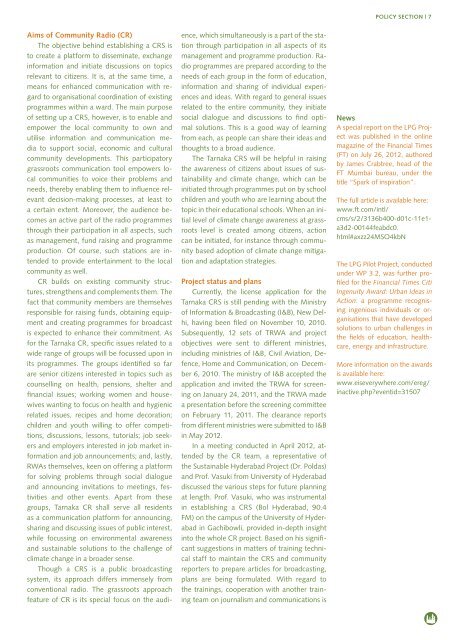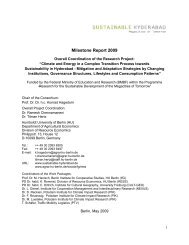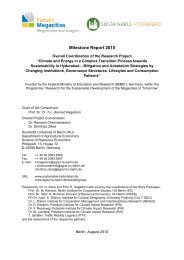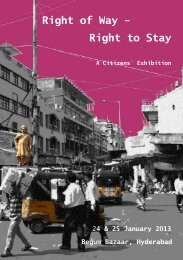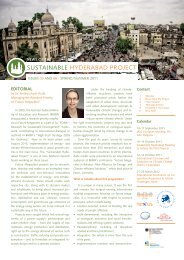SUSTAINABLE HYDERABAD PROJECT
SUSTAINABLE HYDERABAD PROJECT
SUSTAINABLE HYDERABAD PROJECT
Create successful ePaper yourself
Turn your PDF publications into a flip-book with our unique Google optimized e-Paper software.
POLICY SECTION | 7<br />
Aims of Community Radio (CR)<br />
The objective behind establishing a CRS is<br />
to create a platform to disseminate, exchange<br />
information and initiate discussions on topics<br />
relevant to citizens. It is, at the same time, a<br />
means for enhanced communication with regard<br />
to organisational coordination of existing<br />
programmes within a ward. The main purpose<br />
of setting up a CRS, however, is to enable and<br />
empower the local community to own and<br />
utilise information and communication media<br />
to support social, economic and cultural<br />
community developments. This participatory<br />
grassroots communication tool empowers local<br />
communities to voice their problems and<br />
needs, thereby enabling them to influence relevant<br />
decision-making processes, at least to<br />
a certain extent. Moreover, the audience becomes<br />
an active part of the radio programmes<br />
through their participation in all aspects, such<br />
as management, fund raising and programme<br />
production. Of course, such stations are intended<br />
to provide entertainment to the local<br />
community as well.<br />
CR builds on existing community structures,<br />
strengthens and complements them. The<br />
fact that community members are themselves<br />
responsible for raising funds, obtaining equipment<br />
and creating programmes for broadcast<br />
is expected to enhance their commitment. As<br />
for the Tarnaka CR, specific issues related to a<br />
wide range of groups will be focussed upon in<br />
its programmes. The groups identified so far<br />
are senior citizens interested in topics such as<br />
counselling on health, pensions, shelter and<br />
financial issues; working women and housewives<br />
wanting to focus on health and hygienic<br />
related issues, recipes and home decoration;<br />
children and youth willing to offer competitions,<br />
discussions, lessons, tutorials; job seekers<br />
and employers interested in job market information<br />
and job announcements; and, lastly,<br />
RWAs themselves, keen on offering a platform<br />
for solving problems through social dialogue<br />
and announcing invitations to meetings, festivities<br />
and other events. Apart from these<br />
groups, Tarnaka CR shall serve all residents<br />
as a communication platform for announcing,<br />
sharing and discussing issues of public interest,<br />
while focussing on environmental awareness<br />
and sustainable solutions to the challenge of<br />
climate change in a broader sense.<br />
Though a CRS is a public broadcasting<br />
system, its approach differs immensely from<br />
conventional radio. The grassroots approach<br />
feature of CR is its special focus on the audience,<br />
which simultaneously is a part of the station<br />
through participation in all aspects of its<br />
management and programme production. Radio<br />
programmes are prepared according to the<br />
needs of each group in the form of education,<br />
information and sharing of individual experiences<br />
and ideas. With regard to general issues<br />
related to the entire community, they initiate<br />
social dialogue and discussions to find optimal<br />
solutions. This is a good way of learning<br />
from each, as people can share their ideas and<br />
thoughts to a broad audience.<br />
The Tarnaka CRS will be helpful in raising<br />
the awareness of citizens about issues of sustainability<br />
and climate change, which can be<br />
initiated through programmes put on by school<br />
children and youth who are learning about the<br />
topic in their educational schools. When an initial<br />
level of climate change awareness at grassroots<br />
level is created among citizens, action<br />
can be initiated, for instance through community<br />
based adoption of climate change mitigation<br />
and adaptation strategies.<br />
Project status and plans<br />
Currently, the license application for the<br />
Tarnaka CRS is still pending with the Ministry<br />
of Information & Broadcasting (I&B), New Delhi,<br />
having been filed on November 10, 2010.<br />
Subsequently, 12 sets of TRWA and project<br />
objectives were sent to different ministries,<br />
including ministries of I&B, Civil Aviation, Defence,<br />
Home and Communication, on December<br />
6, 2010. The ministry of I&B accepted the<br />
application and invited the TRWA for screening<br />
on January 24, 2011, and the TRWA made<br />
a presentation before the screening committee<br />
on February 11, 2011. The clearance reports<br />
from different ministries were submitted to I&B<br />
in May 2012.<br />
In a meeting conducted in April 2012, attended<br />
by the CR team, a representative of<br />
the Sustainable Hyderabad Project (Dr. Poldas)<br />
and Prof. Vasuki from University of Hyderabad<br />
discussed the various steps for future planning<br />
at length. Prof. Vasuki, who was instrumental<br />
in establishing a CRS (Bol Hyderabad, 90.4<br />
FM) on the campus of the University of Hyderabad<br />
in Gachibowli, provided in-depth insight<br />
into the whole CR project. Based on his significant<br />
suggestions in matters of training technical<br />
staff to maintain the CRS and community<br />
reporters to prepare articles for broadcasting,<br />
plans are being formulated. With regard to<br />
the trainings, cooperation with another training<br />
team on journalism and communications is<br />
News<br />
A special report on the LPG Project<br />
was published in the online<br />
magazine of the Financial Times<br />
(FT) on July 26, 2012, authored<br />
by James Crabtree, head of the<br />
FT Mumbai bureau, under the<br />
title “Spark of inspiration”.<br />
The full article is available here:<br />
www.ft.com/intl/<br />
cms/s/2/3136b400-d01c-11e1-<br />
a3d2-00144feabdc0.<br />
html#axzz24MSO4kbN<br />
The LPG Pilot Project, conducted<br />
under WP 3.2, was further profiled<br />
for the Financial Times Citi<br />
Ingenuity Award: Urban Ideas in<br />
Action: a programme recognising<br />
ingenious individuals or organisations<br />
that have developed<br />
solutions to urban challenges in<br />
the fields of education, healthcare,<br />
energy and infrastructure.<br />
More information on the awards<br />
is available here:<br />
www.eiseverywhere.com/ereg/<br />
inactive.php?eventid=31507


